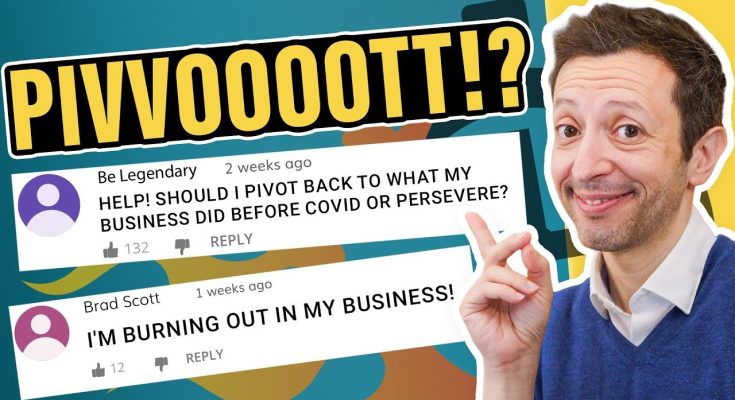In the dynamic, often unpredictable, currents of the business world, the concept of a “pivot” has emerged as a critical maneuver for survival and growth. Far from being a sign of failure or a desperate last resort, a business pivot is a strategic shift in direction, a conscious decision to change a core aspect of a company’s product, market, or strategy in response to new information, market feedback, or unforeseen challenges. It’s an act of agility, demonstrating a founder’s willingness to adapt and evolve rather than cling to an original vision that may no longer be viable. Understanding what constitutes a pivot and, crucially, when to execute such a significant change, is a hallmark of resilient entrepreneurship.
At its essence, a pivot is not merely a minor adjustment or a cosmetic change. It’s a fundamental reorientation. For example, it could mean shifting from selling directly to consumers (B2C) to focusing exclusively on business clients (B2B), or altering a product from a physical good to a software-as-a-service (SaaS) model. It might involve targeting an entirely new customer segment with an existing offering, or even developing a completely new product based on lessons learned from a previous iteration. The common thread among all pivots is a recognition that the initial hypothesis or market approach is not yielding the desired results, and a new, more promising path needs to be forged.
Consider the well-documented story of Flickr, which famously began as a role-playing game called “Game Neverending.” During the development of the game, its creators built a photo-sharing tool to facilitate communication among players. They soon realized that the photo-sharing component was gaining more traction and interest than the game itself. This insight led to a classic pivot: abandoning the game to focus entirely on the photo-sharing platform, which went on to become a massive success. This illustrates a “zoom-in” pivot (focusing on a single feature) or a “side project” pivot, where an ancillary tool becomes the primary business.
The question of when to pivot is often the most challenging, as it requires a delicate balance of patience, perseverance, and objective self-assessment. Holding onto a flawed strategy for too long can deplete resources, damage morale, and ultimately lead to outright failure. Conversely, pivoting too soon, without sufficient data or iteration, can mean abandoning a potentially viable idea prematurely.
One of the strongest indicators that a pivot might be necessary is consistent negative market feedback or a lack of traction. If customers aren’t buying, if conversion rates are abysmal despite significant effort, or if early adopters are consistently expressing disinterest in the core offering, these are flashing red lights. This isn’t about giving up at the first hurdle; it’s about discerning between temporary setbacks and fundamental misalignment. Are customers simply not understanding the value proposition, or is there genuinely no market for what’s being offered? Engaging in structured customer interviews, A/B testing, and analyzing usage data can provide the objective evidence needed to inform this decision.
Another compelling reason to pivot arises when a significant change in the market or competitive landscape occurs. A new technological breakthrough, the entry of a dominant competitor, or a shift in consumer behavior could render an existing business model obsolete or unsustainable. For instance, a DVD rental business in the early 2000s might have seen the rise of streaming services as a clear signal to pivot their strategy, perhaps by transitioning to a digital streaming model themselves or focusing on niche physical media. Ignoring such monumental shifts is often a recipe for obsolescence.
Furthermore, resource constraints and an inability to scale can also necessitate a pivot. A business might find that its current model is too resource-intensive, requiring unsustainable levels of capital, time, or specialized talent that are simply not available or feasible to acquire. A pivot in such cases might involve simplifying the product, targeting a less demanding market segment, or adopting a more efficient operational model. The goal is to find a path to sustainable growth that aligns with available resources.
Finally, founder fatigue or a loss of passion can, surprisingly, be a legitimate signal for a pivot. Entrepreneurship is an intensely personal journey, and sustained engagement requires genuine belief and excitement. If the founders or core team have lost their conviction in the current direction, it becomes incredibly difficult to inspire others, innovate, and overcome obstacles. In such instances, a pivot can reignite passion by offering a fresh challenge and a renewed sense of purpose. This isn’t about avoiding hard work but recognizing when the energy is no longer being effectively channeled.
Executing a pivot demands courage, humility, and a data-driven approach. It often requires shedding previous assumptions and embracing a new narrative. It’s a testament to an entrepreneur’s adaptability and their commitment to finding a true market fit, rather than stubbornly adhering to an initial, unproven vision. Ultimately, a well-timed and thoughtfully executed pivot is not a retreat, but a strategic leap forward, enabling a business to shed what isn’t working and embrace a direction that holds genuine promise for long-term success.




